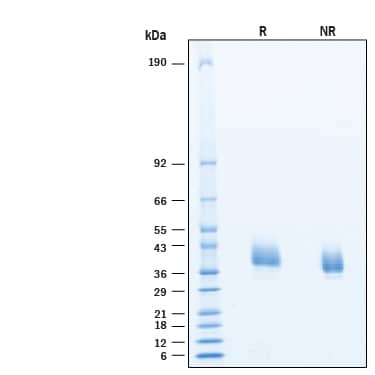Recombinant Human EpCAM/TROP1 Avi-tag His-tag Protein, CF
R&D Systems, part of Bio-Techne | Catalog # AVI9277
Biotinylated

Key Product Details
Source
CHO
Accession #
Structure / Form
Biotinylated via Avi-tag
Conjugate
Biotin
Applications
Bioactivity
Product Specifications
Source
Chinese Hamster Ovary cell line, CHO-derived human EpCAM/TROP1 protein
| Human EpCAM (Gln24-Lys265) Accession # P16422.2 |
Avi-tag | 6-His tag |
| N-terminus | C-terminus |
Purity
>95%, by SDS-PAGE visualized with Silver Staining and quantitative densitometry by Coomassie® Blue Staining.
Endotoxin Level
<0.10 EU per 1 μg of the protein by the LAL method.
N-terminal Sequence Analysis
Gln24
Predicted Molecular Mass
31 kDa
SDS-PAGE
35-42 kDa, under reducing conditions.
Activity
Measured by its binding ability in a functional ELISA.
Biotinylated Recombinant Human EpCAM/TROP‑1 Avi-tag His-tag (Catalog # AVI9277) binds to Human EpCAM/TROP-1 Antibody (Catalog # AF960) with a ED50 of 0.750-7.50 ng/mL.
Biotinylated Recombinant Human EpCAM/TROP‑1 Avi-tag His-tag (Catalog # AVI9277) binds to Human EpCAM/TROP-1 Antibody (Catalog # AF960) with a ED50 of 0.750-7.50 ng/mL.
Scientific Data Images for Recombinant Human EpCAM/TROP1 Avi-tag His-tag Protein, CF
Biotinylated Recombinant Human EpCAM/TROP‑1 Avi-tag His-tag Protein Binding Activity.
Measured by its binding ability in a functional ELISA. Biotinylated Recombinant Human EpCAM/TROP‑1 Avi-tag His-tag (Catalog # AVI9277) binds to Human EpCAM/TROP-1 Antibody (AF960) with a ED50 of 0.750-7.50 ng/mL.Biotinylated Recombinant Human EpCAM/TROP‑1 Avi-tag His-tag Protein SDS-PAGE.
2 μg/lane of Biotinylated Recombinant Human EpCAM/TROP‑1 Avi-tag His-tag Protein (Catalog # AVI9277) was resolved with SDS-PAGE under reducing (R) and non-reducing (NR) conditions and visualized by Coomassie® Blue staining, showing bands at 35-42 kDa.Formulation, Preparation and Storage
AVI9277
| Formulation | Lyophilized from a 0.2 μm filtered solution in PBS with Trehalose. |
| Reconstitution | Reconstitute at 500 μg/mL in PBS. |
| Shipping | The product is shipped at ambient temperature. Upon receipt, store it immediately at the temperature recommended below. |
| Stability & Storage | Use a manual defrost freezer and avoid repeated freeze-thaw cycles.
|
Background: EpCAM/TROP1
References
- Strnad, J. et al. (1989) Cancer Res. 49:314.
- Schnell, U. et al. (2013) Biochim. Biophys. Acta 1828:1989.
- Ng, V.Y. et al. (2010) Stem Cells 28:29.
- Nelson, A.J. et al. (1996) Eur. J. Immunol. 26:401.
- Borkowski, T.A. et al. (1996) Eur. J. Immunol. 26:110.
- de Boer, C.J. et al. (1999) J. Pathol. 188:201.
- Litvinov, S.V. et al. (1994) J. Cell Biol. 125:437.
- Balzar, M. et al. (2001) Mol. Cell. Biol. 21:2570.
- Nubel, T. et al. (2009) Mol. Cancer Res. 7:285.
- Kuhn, S. et al. (2007) Mol. Cancer Res. 5:553.
- Schmidt, D.S. et al. (2004) Exp. Cell Res. 297:329.
- Litvinov, S.V. et al. (1997) J. Cell Biol. 139:1337.
- Gaiser, M.R. et al. (2012) Proc. Natl. Acad. Sci. USA 109:E889.
- Schnell, U. et al. (2013) Biosci. Rep. 33:e00030.
- Schon, M.P. et al. (1993) Int. J. Cancer 55:988.
- Maetzel, D. et al. (2009) Nat. Cell Biol. 11:162.
Long Name
Epithelial Cell Adhesion Molecule
Alternate Names
17-1A, CD326, GA733-2, gp40, KS1/4, M4S1, TACSTD1, TROP1
Gene Symbol
EPCAM
UniProt
Additional EpCAM/TROP1 Products
Product Documents for Recombinant Human EpCAM/TROP1 Avi-tag His-tag Protein, CF
Product Specific Notices for Recombinant Human EpCAM/TROP1 Avi-tag His-tag Protein, CF
For research use only
